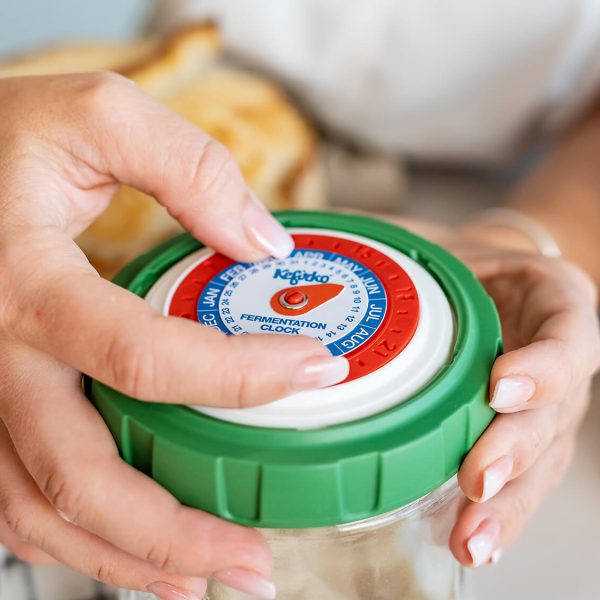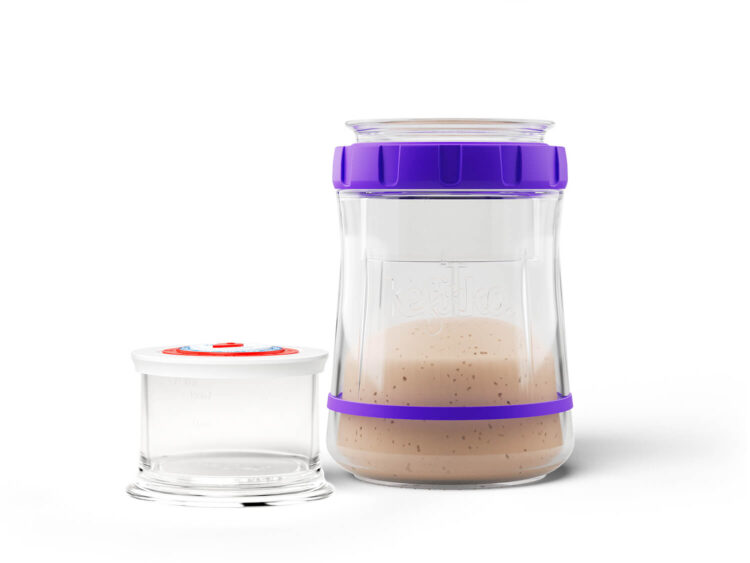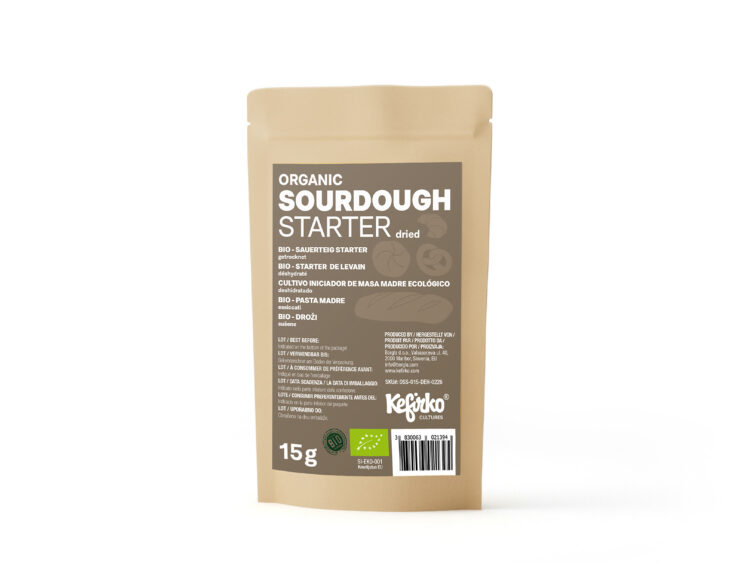SOURDOUGH FERMENTING

See answers to the FAQ about sourdough fermenting below.
You will need an active sourdough starter if you want to bake sourdough goods. Active starter has a yeasty smell and bubbles. It quickly doubles after being fed.
- Option 1: You can have a dormant starter in your refrigerator or someone gives you a tiny portion of their starter. This provides you with a live starter that you can use in recipes after feeding it once or twice.
- Option 2: Buy dried sourdough starter (check out Kefirko Organic ingredients range). You are given a powdered starter that must first be activated. This may take a couple of days (2-3).
- Option 3: Make sourdough from scratch. This process takes the longest because a live starter needs to be created by feeding the flour’s microorganisms for at least seven days.
Creating a sourdough baking schedule that fits your lifestyle can be challenging, but it is worth the effort. But you can create a baking schedule that allows you to enjoy fresh, homemade sourdough bread regularly without disrupting your daily routine.
If you have busy weekdays and only want to bake on weekends but want to enjoy sourdough bread every day, here is an example of how you can plan your baking.
- Friday evening:
Remove your sourdough starter from the refrigerator and let it sit at room temperature for about 1-2 hours.
Feed the small portion of starter with equal amounts of flour and water, stirring well to incorporate air. This will be your levain for the next day’s bake.
Cover the jar loosely and let it sit at room temperature overnight or for about 8-12 hours.
Return the remaining starter to the refrigerator for storage until the next week. - Saturday morning:
In the morning, check the levain. It should be bubbly and active, with a pleasant aroma.
Prepare the dough by combining it with the remaining ingredients (flour, water, salt, etc.) according to your favourite sourdough bread recipe. Follow the recipe’s instructions for kneading, folding, or shaping the dough.
Let the dough go through its fermentation and proofing stages as specified in the recipe. This usually takes several hours, depending on the temperature and the specific recipe. - Saturday evening:
Bake your sourdough bread according to the recipe’s instructions. Enjoy the freshly baked bread and store the bread for the weekday in the bread bag or freeze small portions and thaw them the day before you want to use them.
Adjust the quantities and feeding schedules based on your preferences and the specific sourdough bread recipe you are using. If you want to bake more than one loaf for a week, you will need more levain too.
Here is a recipe for preparing the sourdough starter from scratch.
- Combine 30g of flour and 25ml of water.
- After 48 hours feed with 30g flour and 25 ml water. Let sit for another 24 hours.
- Discard half of the starter and feed it with 30g flour and 25 ml water. Let sit for 24 hours.
- Repeat the 3rd step every day for at least seven days until the starter is active.
To tell if your sourdough starter is active and healthy, there are a few key things to look for:
- Bubbles: bubbles tell us that the yeast in the starter is active and producing carbon dioxide.
- Rise: When you feed your starter, it should at least double in size within a few hours of feeding. This is the sign that yeast is healthy and active.
- Aroma: A healthy sourdough starter should have a pleasant, slightly sour aroma. If it smells unpleasant or strongly of alcohol, it may be time to refresh the starter or adjust your feeding schedule.
- Consistency: A healthy sourdough starter should have a consistent, smooth texture throughout. There should be no mold or discoloration present.
- Activity over time: Over the course of a few days or weeks, your sourdough starter should continue to show signs of activity and growth.
By looking for these signs, you can ensure that your sourdough starter is active and healthy, and ready to use in your favourite sourdough recipes.
Feeding and caring for your sourdough starter is essential to maintain its health and ensure successful sourdough baking.
Here are the steps to properly feed and care for your sourdough starter:
- Choose the right equipment: Use a glass container with a lid to store your sourdough starter. Avoid metal containers, as they can react with the acid in the starter.
- Feed the starter regularly: The frequency of feedings depends on the environment and how active the starter is. Generally, you should feed the starter once a day or every 12 hours. To feed the starter, discard about half of the starter and replace it with equal parts flour and water by weight.
- Maintain a consistent feeding schedule: Choose a feeding schedule that works for you and stick to it. If you need to adjust the schedule, do so gradually over several days.
- Store the starter at the right temperature: Sourdough starters prefer warm, humid environments. Ideally, store your starter between 24-29°C.
- Use quality ingredients: Sourdough starters are sensitive to the quality of water and flour used in feeding. Use filtered water and high-quality flour to ensure the best results.
By following these steps, you can properly feed and care for your sourdough starter and maintain its health and activity for successful sourdough baking.
Storing sourdough bread properly is important for maintaining its freshness and texture. Here are some tips on how to do it:
- Allow the bread to cool completely: This will prevent moisture from building up inside the container or bag and keep the bread from getting soggy.
- Wrap the bread in paper or cloth: Avoid storing sourdough bread in plastic bags, as they can trap moisture and cause the bread to become soggy. Instead, wrap the bread in paper or cloth to allow it to breathe.
- Store at room temperature: Sourdough bread is best stored at room temperature, away from direct sunlight and heat sources. A bread box or a paper bag works well for this purpose.
- Freeze for longer storage: Wrap the bread tightly in a resealable plastic bag. Frozen sourdough bread can last up to three months.
- Reheat before eating: If your sourdough bread has become stale, you can revive it by reheating it. Place the bread in a preheated oven at 180°C for 10-15 minutes, or until it’s heated through.
By following these tips, you can keep your sourdough bread fresh and delicious for longer.
It’s important to properly store sourdough starter to keep it healthy and active for future baking.
- Take only a small portion of the existing starter and put it in a non-reactive container.
- Add equal parts (by weight) of flour and water to the small amount of starter you left in the bowl. For example, if you have 1/4 cup of starter, add 1/4 cup of flour and 1/4 cup of water. Mix well until you have a smooth consistency.
- For longer-term storage (e.g., more than one week to months), store the container with the loosely covered lid in the refrigerator. The cooler temperature will slow down the fermentation process, and you can take it out and feed it once a week to keep it alive.
Products
-

Sourdough Fermenter
35.60 €Rated 5.00 out of 5Select options This product has multiple variants. The options may be chosen on the product page -

ORGANIC SOURDOUGH STARTER 15g
12.70 € -

Bread bag
7.29 €


